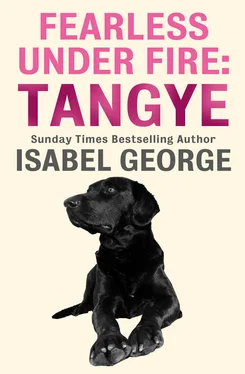
Fearless Under Fire
Tangye
A Short Tale from BEYOND THE CALL OF DUTY
Heart-warming stories of canine devotion and bravery
by Isabel George

Dedication
To my parents who showed, by example, that courage, loyalty and love really can conquer all
Epigraph
‘“I am serving in Afghanistan and have befriended a young stray dog that lives in the military base where I am stationed. Can you please help me rescue it? I just can’t leave it here to starve.”
‘I smiled as I read the email. I needed to reply quickly. I knew that the soldier would want to know there was somebody else in the world who thought like he did. I had another dog to rescue.’
(Pen Farthing – ex-Royal Marine Commando and founder of the charity NOWZAD, which is dedicated to rescuing animals like Tangye in war-torn Afghanistan. One Dog at a Time, Ebury Press.)
Contents
Cover
Title Page Fearless Under Fire Tangye A Short Tale from BEYOND THE CALL OF DUTY Heart-warming stories of canine devotion and bravery by Isabel George
Dedication
Epigraph
Chapter 1: Tangye – Fearless Under Fire
Afterword
Bibliography
About the Author
Copyright
About the Publisher Конец ознакомительного фрагмента. Текст предоставлен ООО «ЛитРес». Прочитайте эту книгу целиком, купив полную легальную версию на ЛитРес. Безопасно оплатить книгу можно банковской картой Visa, MasterCard, Maestro, со счета мобильного телефона, с платежного терминала, в салоне МТС или Связной, через PayPal, WebMoney, Яндекс.Деньги, QIWI Кошелек, бонусными картами или другим удобным Вам способом.
Chapter 1
Tangye –
Fearless Under Fire
Tangye was a tiny bundle of dusty black fur when Rik Groves of 29 Commando, Royal Artillery first set eyes on him. The puppy was lying on the floor at the feet of an Afghan security guard whose huge boots dwarfed the scrap of a dog. Maybe it was the unfamiliar sound of the English accent that interested him enough to raise his head out of the hot dirt but it was a chance for the soldier to catch a glimpse of what looked like a Labrador’s face. No more than five or six weeks old, he was too young to be without his mother and maybe that explained why he was never more than a paw’s pace from the yellowish, Corgi-type dog that was strutting around him. That dog looked streetwise but the pup’s sad and innocent expression bothered the soldier and, unable to resist any longer, he reached down to stroke its bony body. That first touch was the start of a four year friendship that was to brighten the days and hearten the morale of British soldiers stationed in one of the most dangerous places on earth.
* * *
Kajaki lies on the Helmand River approximately 160 kilometres north of Camp Bastion and 100 kilometres northeast of Helmand Province’s capital, Lashkar Gãh. The only way to reach the mountainous Kajaki by road is to take Highway 611 which winds through the Taliban-infested desert and patches of scrubland that typify the area. The road is a recognized hotspot for insurgent activity and troops taking this long and perilous road face the ever-present dangers of being ambushed and falling victim to IEDs (Improvised Explosive Devices) designed to cause maximum harm to anyone in their path. At the heart of this stark desert base shimmer the turquoise waters of the Kajaki Dam. The vast pool is the only visible respite from the blinding dazzle of the white sand. In summer, with temperatures reaching around 50°C and in winter falling to a little as –25°C, it is a desperately inhospitable place to live at any time of year. The rains which come between October and April provide little respite from the extremes as they only turn the sand into deep, clinging, yellow mud. The contrast between the heat of the day and the cold nights can deceive the newcomer and prove a harsh reality for stray dogs that roam the area.
Dogs found wandering in Afghan communities are no longer adopted as pets. Since the arrival of the Taliban, dogs are considered to be dirty and are treated with disdain; they are commonly shunned and often abused and tortured. It is not unusual to see a puppy used as a football in the street or kept lean and mean to fight for money. The harsh reality for many dogs in Afghanistan is that if he is not a good fighter his life will not be worth living and it will be painfully short. Luckily, little Tangye did not have the telltale signs of a dog being groomed for fighting. For a start, he still had his ears and tail intact. And, looking at the skinny bag of bones that he was, it was unlikely Tangye would develop the necessary physique to be a prize fighter. In that respect, Tangye was maybe one of the lucky ones: too skinny to be a fighter, too small to be a threat but attractive enough to be adopted by the guards stationed at the Kajaki Dam militia post. Tethered to a stake, given no food and no water. Just there. That was Tangye.
Warrant Officer Rik Groves was heading up the first Operations Mentoring Liaison Team (OMLT) the British Army had raised in the Kajaki area since the Taliban poured out of the religious schools and refugee camps of Pakistan and Kandahar twelve years before. His right-hand man was Sergeant Lee Mildener of 45 Commando, Royal Marines and, to help them both communicate with the local people, an interpreter went along too. In charge of ten or so Afghan National Army (ANA) soldiers, this was an embryonic force created to establish a good working and living relationship with the local people, most importantly the local tribesmen and elders who hold sway in their communities. These people had lived and thrived quite happily on their land and prospered by farming cereal and growing fruit and continuing a culture that embraced the rituals of an ancient people. The terrorist attack on New York’s World Trade Center on 11 September 2001 changed all of that. Terrorism had raised its ugly head in the spotlight of the world and the war against its leader, Osama bin Laden, all associated with him and those protecting him was declared by the United States and backed by the British Government.
On 7 October 2001, two British hunter-killer submarines entered the Arabian Sea off the coast of Pakistan. Nuclear ships HMS Trafalgar and HMS Triumph launched a hail of Tomahawk cruise missiles. The 455-kilogramme guided missiles destroyed a Taliban training school in the Afghan countryside. It was the start of a targeted aerial bombing campaign that gave the overthrown Afghan Northern Alliance the power to return fire on their attacker, the Taliban. Under the direction of their warlord general, Rashid Dostum, and backed by the US Special Forces, the Alliance retook the holy city of Mazar-i-Sharif and powered south to regain Kabul. That was on 21 November 2001, the same day the Alliance also took control of Bagram airbase, a strategically vital move.
What followed was two years of consolidation for the Afghan National Alliance with the support of the British and US Forces. The thrust of each military operation was to secure the position of the Alliance against the Taliban and capture the insurgents, giving them little time or space to retreat to their stronghold over the Pakistan border. By the time the US and British Governments began to turn their attention to the activities in Iraq in 2003, the position in Afghanistan was favourable to the Alliance.
Читать дальше














